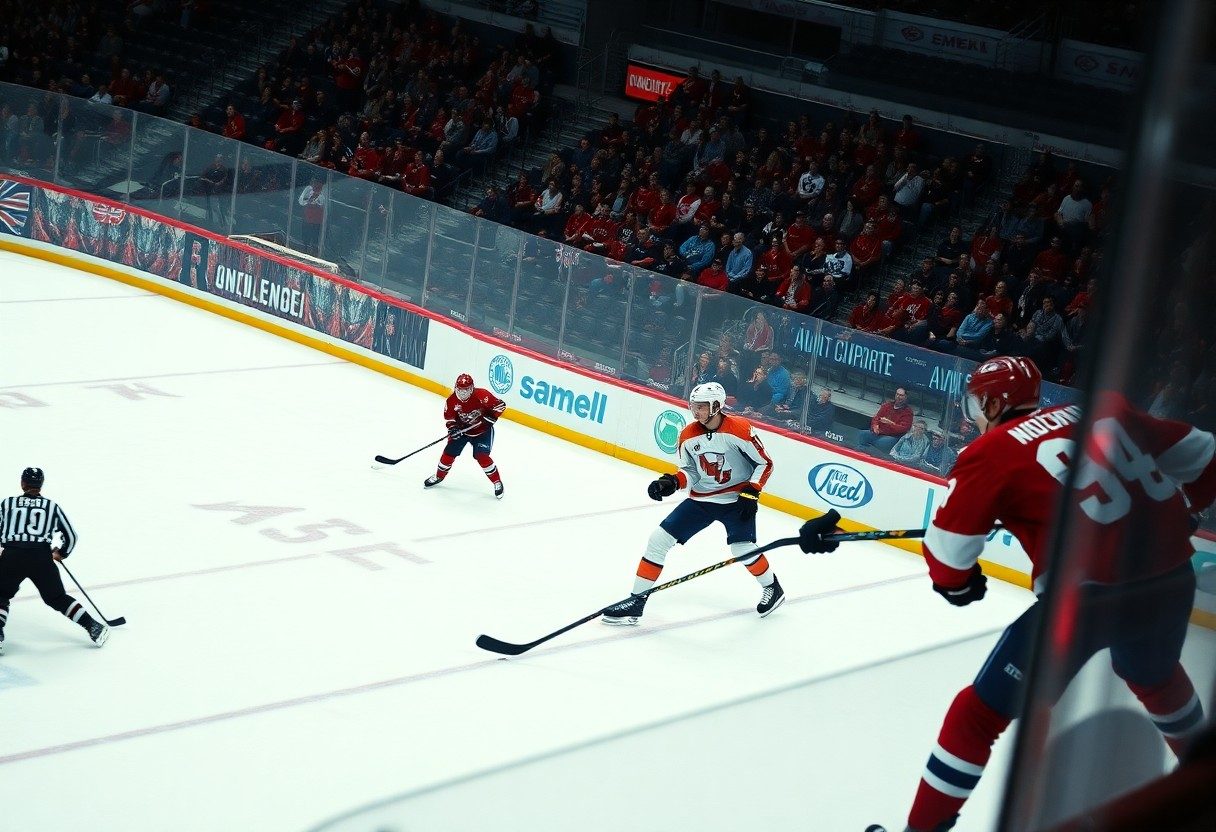Over the years, both hockey and poker have captivated audiences with their unique blend of skill and strategy, but you may find yourself wondering which game truly demands more tactical thinking. In this guide, we will probe into the strategic depths of both sports, comparing their complexities and nuances to help you understand how each requires a different mindset and approach. By examining key elements, you can discover where your own strategic inclinations might thrive better—on the ice or around the poker table.
Types of Strategies in Hockey
Before delving into the intricacies of hockey strategy, it’s vital to understand the various approaches teams adopt to outsmart their opponents. Here’s a breakdown of key strategic types:
| Strategy Type | Description |
|---|---|
| Offensive | Focuses on scoring goals through aggressive plays. |
| Defensive | Emphasizes protecting the goal and preventing opponent scoring. |
| Transition | Strategies for moving between offense and defense quickly. |
| Special Teams | Involve power plays and penalty kills. |
| Game Management | Adapting strategy based on the game’s score and time left. |
The variety of these strategies allows teams to adapt to different opponents and game situations.
Offensive Strategies
Clearly, offensive strategies are designed to increase your team’s scoring opportunities. These can include puck possession techniques, such as passing, cycling, and formation plays, to create high-quality shot chances against the opponent’s goalie.
Defensive Strategies
Strategies emphasize a sound defensive setup to thwart opponents’ scoring attempts. By maintaining tight formations, you can effectively limit their space and options.
A well-executed defensive strategy might involve zone coverage or man-to-man marking, ensuring players are positioned to quickly respond to opposing players’ movements. Effective communication and anticipation are key components, allowing you to disrupt plays and capitalize on turnovers, which can lead to swift transitions to your offensive strategies.
Types of Strategies in Poker
While playing poker, you’ll encounter various strategies that can significantly impact your success at the table. Each approach can be tailored to your playing style and the specific dynamics of the game. Here are some common strategies you may consider:
- Bluffing
- Value Betting
- Position Play
- Hand Ranges
- Adjusting to Opponents
Recognizing the right moments to apply these strategies can elevate your game to new heights.
| Type of Strategy | Description |
|---|---|
| Bluffing | Deceiving opponents by acting strong with weak hands. |
| Value Betting | Betting strong hands to extract maximum value from opponents. |
| Position Play | Utilizing your seat at the table to make informed decisions. |
| Hand Ranges | Estimating opponents’ potential holdings based on their actions. |
| Adjusting to Opponents | Changing your strategy based on your opponents’ tendencies. |
Pre-flop Strategies
Strategies pre-flop focus on how you approach the initial betting round. This is where you decide whether to fold, call, or raise based on your hole cards and position at the table. Understanding your hand strength and assessing opponents’ tendencies are vital during this phase. Additionally, recognizing the importance of position can influence whether you enter the pot or wait for a better opportunity on future hands.
Post-flop Strategies
Strategies post-flop involve making calculated decisions after the community cards are revealed. At this stage, you should assess the strength of your hand relative to the board and your opponents’ actions. You must adapt your play based on the type of flop and how your opponents react, which could involve aggressive betting, checking, or folding depending on the circumstances.
The strategies during this phase can vary greatly and may require you to think critically about the combination of cards already on the table and the potential hands your opponents could be holding. Your ability to read the board and take advantage of the situation can directly influence your win rate. Whether you choose to continue applying pressure or play conservatively depends on the specific circumstances and dynamics of the game at that moment.
Tips for Success in Hockey
To excel in hockey, you need to develop a solid foundation of skills and strategies. Here are some tips for success:
- Practice your skating technique regularly.
- Work on your shooting accuracy and speed.
- Understand positioning and spacing on the ice.
- Enhance your physical fitness through conditioning.
- Communicate effectively with your teammates.
Knowing these tips can aid you in becoming a more effective player and enhance your overall game performance.
Training and Preparation
Training your body and mind is vital for hockey success. Focus on building endurance, strength, and agility through various on-ice and off-ice exercises. Balance skill drills with tactical understanding, such as learning plays and setups. Regular assessments and goal-setting can also keep you motivated and on track for improvement.
Game-Time Decision Making
Game-time decisions can make or break a play in hockey. You must quickly assess situations and choose your actions wisely. Factors such as the game situation, team strategy, and opponent positions must all play a role in your decisions.
With experience, you’ll learn to read the game better and anticipate plays. Refining your instincts allows you to make split-second choices, whether it’s passing, shooting, or positioning yourself defensively. Trust your training, remain calm under pressure, and always be prepared to adapt your strategy based on the evolving dynamics of the game.
Tips for Success in Poker
Your success in poker comes down to a mix of strategy, discipline, and understanding the game. Implement these imperative tips:
- Practice regularly to sharpen your skills.
- Pay attention to your opponents’ betting patterns.
- Stay patient and avoid emotional play.
- Review your sessions to identify mistakes.
- Know when to fold and protect your chips.
The combination of these skills will define your journey as a successful player.
Reading Opponents
One of the key aspects of poker strategy is reading your opponents effectively. Pay close attention to their behaviors, betting patterns, and facial expressions. By collecting and analyzing these cues, you can make more informed decisions on when to bluff, call, or fold. Developing this skill not only helps you understand the dynamics of the game but also allows you to adapt your strategy based on what others might be thinking.
Bankroll Management
On top of reading opponents, effective bankroll management is a vital component of a successful poker strategy. You must allocate your funds wisely and avoid risking more money than you can afford to lose. Establish a budget for each session, set limits for wins and losses, and choose stakes that align with your bankroll size. Doing so not only minimizes your chances of going broke but also helps maintain a strategic mindset during gameplay.
Opponents may vary in their skill levels and playing styles, but your approach to bankroll management should remain consistent. Treat your bankroll as a long-term investment, protecting your funds while maximizing growth opportunities. By adhering to strict management rules, you enhance your potential for success and create a more enjoyable playing experience.
Step-by-Step Guide to Hockey Tactics
Keep your game sharp by exploring key hockey tactics. Understanding these elements will elevate your performance on the ice:
| Tactic | Description |
| Forechecking | Pressure the opponent’s defense to regain possession. |
| Backchecking | Swift return to defend after an offensive play. |
| Power Play | Utilizing numerical advantage creatively during penalties. |
| Penalty Kill | Defending effectively while a player is in the penalty box. |
Positioning and Movement
On the ice, your positioning and movement are imperative. You must consistently anticipate plays, while maintaining an optimal stance that enables quick reactions. Effective spacing between players allows for better puck control and offensive opportunities.
Execution of Plays
Hockey relies heavily on executing plays with precision. You need to communicate effectively with your teammates; this ensures that everyone is on the same page during offensive and defensive maneuvers. The ability to execute predetermined plays can turn the tide of the game in your favor.
Execution involves each player knowing their role and responsibilities during a play. As you practice these strategies, focus on timing and support among teammates. Whether you’re setting up a scoring chance or defending against an attack, coordinated execution ensures that your tactics manifest into positive outcomes on the scoreboard.

Step-by-Step Guide to Poker Gameplay
Now, let’s explore the fundamentals of poker gameplay. Understanding the game’s structure can enhance your experience. Here is a step-by-step breakdown:
| Step | Description |
| 1 | Gather players and set up the table. |
| 2 | Choose the type of poker game. |
| 3 | Distribute cards as per the game rules. |
| 4 | Initiate the betting round. |
| 5 | Reveal community cards, if applicable. |
| 6 | Conduct subsequent betting rounds. |
| 7 | Determine the winner using hand rankings. |
Understanding Hand Rankings
Some hand rankings are necessary for your success in poker. Familiarizing yourself with these rankings will help you make informed decisions during gameplay, as you assess your hand against both your opponents’ hands and community cards.
Betting Strategies
The strategy you employ in betting can dramatically impact your chances of winning. It’s not just about what cards you hold; how you play them is equally important.
Rankings of hands in poker dictate how you approach betting. For instance, if you have a strong hand like a flush, aggressive betting could force opponents to fold before they can realize their position. Conversely, if your hand is weaker, consider employing a more cautious strategy, such as checking or calling, to gauge your opponents’ strength without committing too many chips. Adapting your betting strategy based on your hand and the table dynamics will greatly improve your gameplay experience.
Pros and Cons of Each Game
Once again, both hockey and poker present unique benefits and challenges for players. It’s imperative to weigh these factors before venturing into either game. Below is a comparative overview that highlights the pros and cons inherent to each.
Pros and Cons of Hockey and Poker
| Hockey | Poker |
|---|---|
| Fast-paced action | Strategic depth |
| Physical endurance | Emotional control |
| Team collaboration | Individual skill |
| Outdoor excitement | Indoor convenience |
| Clear winner determined | Non-linear outcomes |
| Risk of injuries | Can be mentally exhausting |
| Time-consuming commitment | Requires investment |
| Requires special equipment | Varied skills in play |
| Demanding physical training | Long hours of practice |
| Competitive environment | Risk of confrontation |
Advantages of Hockey
Game play involves a thrilling blend of speed and teamwork, making hockey an exhilarating choice for those who thrive in a dynamic environment. The physicality of the sport not only boosts your cardiovascular health but also enhances camaraderie, as players bond through shared victories and challenges on the ice. Your ability to read the game and adjust tactics swiftly adds layers to your strategic involvement, making each match unique and engaging.
Advantages of Poker
Some players appreciate poker for its deep strategic layers and psychological nuances. Mastering poker encourages critical thinking, patience, and self-discipline, which can sharpen your cognitive skills both at the table and in everyday life. The flexibility to play poker online or in person also enhances your accessibility to the game, allowing you to engage whenever it suits your schedule.
Pros of poker extend beyond mere entertainment; they encompass valuable life skills. As you analyze opponents’ behaviors and betting patterns, your understanding of human psychology and decision-making improves. This analytical approach can benefit you in other areas, such as business negotiations, relationships, and personal development.
Disadvantages of Hockey
If you choose hockey, be prepared for the physical toll it can take on your body. The intensity of the sport often leads to injuries, which can sideline you for extended periods. Additionally, developing the necessary skills requires a significant time investment for practice and conditioning, which may not fit everyone’s lifestyle. Hockey also tends to be costlier due to equipment and team fees.
The commitment required for hockey can be overwhelming, especially for beginners. You may find it difficult to balance training schedules with personal or professional obligations. Furthermore, the competitive nature of the sport can introduce stress, which might detract from the enjoyment of the game.
Disadvantages of Poker
Pros of poker include a steep learning curve, making it challenging for newcomers to pick up quickly. The lack of physical activity can also deter some, as the game primarily relies on mental acuity rather than fitness. Additionally, players often experience emotional highs and lows, making it a mentally taxing endeavor.
Advantages of poker include the potential for financial gains, but this also brings risks. You may find it hard to separate emotions from decision-making, leading to poor choices and potential losses. The extended hours of concentration required can lead to burnout, which may discourage you from playing in the long run.
To wrap up
On the whole, whether you lean towards hockey or poker, both games demand a high level of strategic thinking, but they challenge you in different ways. In hockey, your decisions must be made swiftly in a fast-paced environment, while poker requires patience and a keen understanding of human psychology. As you explore these games, consider how your personal strengths align with each, and how the varying strategies can enhance your experience and skills in both arenas. Ultimately, your choice will reflect your preferred strategic approach and enjoyment.













